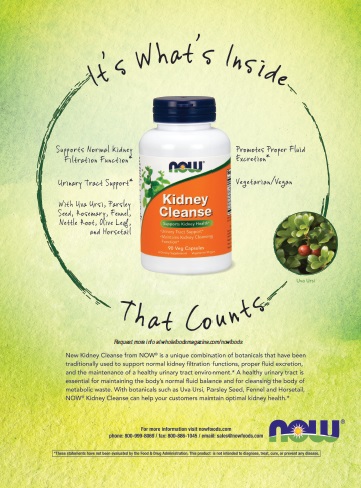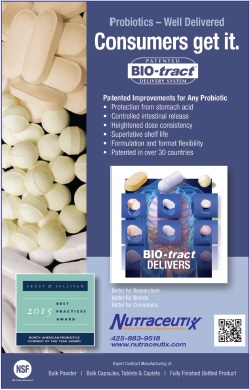Introduce shoppers to friendly bacteria: probiotics. This type of bacteria is good for—and needed by—the body. After thousands of years, probiotics and the human body have developed a symbiotic relationship (1).
Although the word “bacteria” has a negative connotation, human bodies possess microorganisms that outnumber human cells by 10 to one (2). This bacterium allows day-to-day functions in the human body to occur smoothly. An improved immunity, enhanced digestion, a decrease in allergies and improvements in mood are only some of the possible effects probiotics can have on the human body (1).
Women’s Health
The effects of probiotics are especially beneficial for women. The probiotic strain, Lactobacilli, may maintain urogenital health (3). Lactobacilli is an acidic probiotic strain that makes it difficult for harmful bacteria to survive and cultivate in the vaginal ecosystem (3). This probiotic may help balance vaginal microflora, which is important because imbalances may lead to common problems such as bacterial vaginosis (BV), yeast infections and urinary tract infections (3).
BV is a vaginal condition that results from an overgrowth of unwarranted bacteria that can induce infections. A major factor in the growth of BV is the degradation of vaginal Lactobacilli. Diminishing amounts of vaginal Lactobacilli is also a chief factor for BV relapses. Without Lactobacilli bacteria present, the vaginal flora cannot achieve healthy balance (4).
 A case-control study performed between January 2013 and September 2014 at the Department of Gynecological Obstetrics and Urologic Sciences of “Sapienza” University of Rome concluded that probiotic supplementation with vaginal Lactobacillus rhamnosus is a useful remedy for inhibiting harmful bacterial growth in the vaginal microflora (5).
A case-control study performed between January 2013 and September 2014 at the Department of Gynecological Obstetrics and Urologic Sciences of “Sapienza” University of Rome concluded that probiotic supplementation with vaginal Lactobacillus rhamnosus is a useful remedy for inhibiting harmful bacterial growth in the vaginal microflora (5).
A group of 250 non-pregnant sexually active women diagnosed with BV were involved in the study. Group A, 125 patients, were given the traditional treatment for BV (500 mg of an antibiotic orally twice a day for seven days). Group B, the other 125 patients, was given both the standard treatment and vaginal tablets containing Lactobacillus rhamnosus BMX 54. Both groups were observed and analyzed after two, six and nine months. Each patient was analyzed based on treatment tolerability, re-establishment (or lack of) a healthy vaginal flora, recurrence rates of BV and vaginal symptoms (produced by both the standard and alternative treatments) (5).
In contrast to the standard-treated patients in Group A, Group B patients exhibited “significantly” lower rates of BV recurrences. Levels of pH also had a “significant” decrease in Group B patients. Especially with high-risk patients, as the study notes, Lactobacillus vaginal supplements may be contemplated as a new prophylactic treatment for hindering the recurrence of BV (6).
The consistent appearance of Lactobacilli in the vaginal flora is also important for urinary tract health. Research has made a connection between urinary tract infection (UTI) prevention and probiotics (7). Health experts have been exploring and testing remedies that restore the Lactobacilli in the vaginal flora in order to revive the original Lactobacilli in the flora. Recent studies demonstrate that administering an adequate and healthy amount of probiotics has reduced the recurrence rate of UTIs. Some supplements combine probiotics and cranberry extract for this purpose.
Skin Health
The potential connection between the skin and changes in the gastrointestinal microflora is a recent and popular theory that has been a core topic of many new studies. The gut–brain–skin unifying theory has gained attention and validation from studies conducted by scientists and dermatologists. Some believe heightened stress and emotions cause gastrointestinal shifts, which could lead to skin irritation and inflammation. Some feel oral probiotics may help by supporting gut microbiota during times of stress, inflammation and skin issues like acne and eczema (6).
In one published study involving more than 13,000 adolescents, those with acne were more likely to experience gastrointestinal symptoms and were 37% more likely to experience abdominal bloating than those without acne (8).
Lipid peroxidation, the oxidative deprivation of lipids, in acne occurs in high concentration. This high concentration places a great burden on blood-derived antioxidants (substances preventing or delaying damage to cells). Researchers emphasize that if oral probiotics are able to limit systematic oxidative stress, this means a new and significant healing remedy for acne could be crafted (8).
peroxidation, the oxidative deprivation of lipids, in acne occurs in high concentration. This high concentration places a great burden on blood-derived antioxidants (substances preventing or delaying damage to cells). Researchers emphasize that if oral probiotics are able to limit systematic oxidative stress, this means a new and significant healing remedy for acne could be crafted (8).
As Bowe and Logan state in their review, “The gut-brain-skin triangle is not a new notion, but is certainly an avenue worth pursuing with further and more sophisticated investigation. Acne vulgaris is not a disease of gastrointestinal territory, but it is suggested that gut microbes and the health status of the gastrointestinal itself are certainly contributing features to skin conditions, such as acne.”
Aside from acne, oral supplementation with probiotics also has been found to benefit those with atopic dermatitis and even protect the skin from photoaging. A seven-week small-animal trial involving Bifidobacterium strain prior to UVB radiation found probiotics helped protect the skin “possibly via reduced generation of reactive oxygen” (7).
Children’s Health
Links between probiotic supplements and children’s health have also grabbed the attention of scientists studying the effects of probiotics.
A 2012 study, conducted among children in Taiwan, researched a possible connection between probiotic supplement use among young children and overall health of the child’s maturing body (9). Through the use of questionnaires and the Taiwan Birth Cohort study database, researchers collected information about young children from birth through 18 months of age. The study also considered variables, including demographics, low-birth-weight and birth defects. Overall, a sample of 16,991 cases was collected.
While only 6.3% of children received probiotic supplements from birth to six months old, approximately half the children studied received probiotic supplements before or at the age of 18 months old. The study’s results were that “probiotic supplement usage among young children is associated with a more socially advantaged circumstance and healthier lifestyle.”
A 2015 study investigated a possible linkage between a mother’s consumption of probiotic milk products during pregnancy with atopic eczema, rhinoconjuctivitis and asthma in early childhood. The study also took note of infant consumption of milk products in addition to the maternal intake (10).
The data were analyzed from subjects of the Norweigan Mother and Child Cohort Study, which now includes 108,000 children from 90,700 mothers. Participating women completed questionnaires during their pregnancy, at week 18, week 22, and postnatal questionnaires at six months, 18 months and 36 months. Mothers who consumed yogurt and probiotic milk during pregnancy were less likely to have children with atopic eczema by six months of age. The study also showed that when the mother and child both had intakes of probiotics (in comparison to mothers and children who had no intake), they exhibited a slightly reduced risk of eczema at 18 months of age. Between 18 and 36 months of age, children and mothers who both had probiotic intakes were seen as having also a slightly reduced risk of rhinoconjuctivitis.
Immune Health
The immune system and the digestive tract are intrinsically linked. Researchers believe good bacteria in the gut may help support proper immune health as well by “correcting deficiencies and increasing the numbers of certain T cells” (11). While researchers don’t fully understand the connection, it’s thought that Lactobacillus and Bifidobacterium may even support natural killer cell activity.
In one study, workers taking a daily dose of L. reuteri for 80 days took fewer sick days than a placebo group (11). In another study, those taking Lactobacillus gasseri PA 16/8, Bifidobacterium longum SP 07/3 and Bifidobacterium bifidum MF 20/5 had enhanced T-helper and T-suppressor cell activity (11).
Research continues to grow on the exciting probiotic category. Get ready for even more interesting data to be released on the ways probiotics interact with the body beyond digestive health. WF
See WholeFoodsMagazine.com/Supplements for more coverage of the supplements category.
References
1. “What Are Probiotics?” http://probiotics.org/#what-are-probiotics, accessed Sept. 25, 2015.
2. National Center for Complementary and Integrative Health, “Probiotics,” https://nccih.nih.gov/health/probiotics/introduction.htm#key, accessed Sept. 25, 2015.
3. Harvard Medical School, “Health Benefits Of Taking Probiotics,” www.health.harvard.edu/vitamins-and-supplements/health-benefits-of-taking-probiotics, accessed Sept. 25, 2015.
4. G. Reid and A.W. Bruce, “Urogenital Infections In Women: Can Probiotics Help?” Postgrad. Med. J. 79 (934), 428–432 (2003).
5. N. Recine et al., “Restoring Vaginal Microbiota: Biological Control Of Bacterial Vaginosis. A Prospective Case-Control Study Using Lactobacillus Rhamnosus BMX 54 As Adjuvant Treatment Against Bacterial Vaginosis,” Arch. Gynecol. Obstet. Jul 5, 2015.
6. R. Rupani, “Probiotics For Healthy Skin,” June 4, 2015, Dermatology Times, http://dermatologytimes.modernmedicine.com/dermatology-times/news/probiotics-healthy-skin?page=full, accessed Sept. 25, 2015.
7. University of Maryland Medical Center, “Urinary Tract Infection In Women,” https://umm.edu/health/medical/altmed/condition/urinary-tract-infection-in-women, accessed Sept. 25, 2015.
8. W.P. Bowe and A.C. Logan, “Acne vulgaris, Probiotics and the Gut-Brain-Skin Axis—Back To The Future? Gut Pathog. 3: 1 (2011).
9. Y-C Chen et al., “Probiotic Supplement Use among Young Children in Taiwan: A Prospective Cohort Study,” PLoS One 7(9): e43885 (2012).
10. R.J. Bertelsen et al., “Probiotic Milk Consumption In Pregnancy And Infancy And Subsequent Childhood Allergic Diseases,” J. Allergy Clin. Immunol. 2014 Jan; 133(1): 165–171.e8.
11. S. Palmer, “Probiotics’ Potential—Research Suggests Beneficial Bacteria May Support Immune Health, Today’s Dietitian, 13 (1) 20, (2011).
Published in WholeFoods Magazine November 2015









